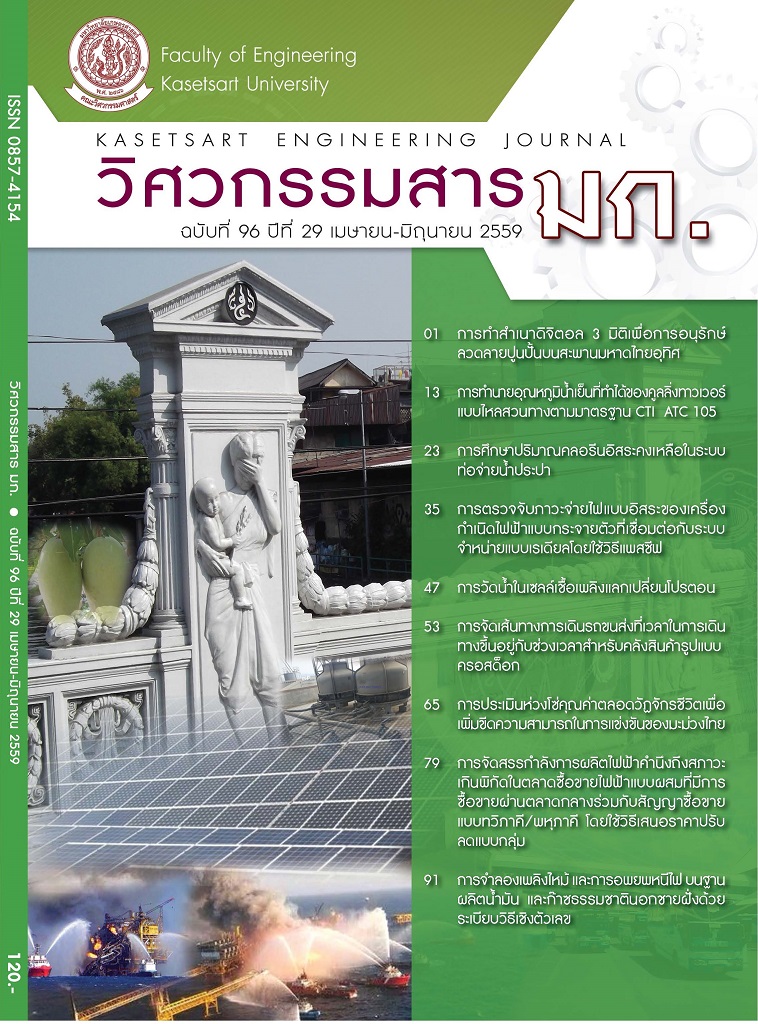การประเมินห่วงโซ่คุณค่าตลอดวัฏจักรชีวิต เพื่อเพิ่มขีดความสามารถในการแข่งขันของมะม่วงไทย
Keywords:
การประเมินห่วงโซ่คุณค่า, วัฏจักรชีวิต, ขีดความสามารถในการแข่งขัน, มะม่วง, value chain assessment, life cycle, competitiveness, mangoAbstract
ปัจจุบันไทยมีการส่งออกผลไม้สดไปจำหน่ายยังตลาดต่างประเทศเป็นจำนวนมาก และมีอัตราการส่งออกเพิ่มขึ้นต่อเนื่อง โดยมะม่วงเป็นหนึ่งในสินค้าหลักที่สำคัญของไทยทั้งในตลาดพรีเมี่ยมและตลาดค้าปลีก ผู้บริโภค ส่วนใหญ่เลือกซื้อสินค้าจากข้อมูลแหล่งผลิต ราคา รสชาติ และรูปลักษณ์ที่แสดงอยู่ในบรรจุภัณฑ์ รวมทั้งข้อมูลด้านผลกระทบต่อสิ่งแวดล้อม และอัตราการใช้ทรัพยากรเพื่อการผลิตสินค้า เช่น การใช้น้ำ และการปล่อยก๊าซเรือนกระจก ซึ่งผู้ผลิตส่วนใหญ่จะนำหลักการประเมินห่วงโซ่คุณค่ามาวิเคราะห์กิจกรรมที่สามารถสร้างคุณค่าได้ โดยมุ่งเน้นการเชื่อมโยงกิจกรรมทั้งภายในและภายนอกองค์กรที่มีผลกระทบต่อประสิทธิภาพการผลิตและความสามารถในการแข่งขัน รวมถึงการวิเคราะห์รูปแบบการใช้ทรัพยากร การสร้างมลพิษ และผลกระทบต่อสิ่งแวดล้อมที่เกิดจากกระบวนการผลิตมะม่วง จากผลการวิเคราะห์ พบว่า เกษตรกรเป็นผู้ใช้น้ำเพื่อการผลิตมากที่สุด และกลุ่มลูกค้าเป็นผู้ปล่อยก๊าซเรือนกระจกมากที่สุด โดยต้นทุนการผลิตส่วนใหญ่อยู่ที่กระบวนการขนส่ง และการเคลื่อนย้ายสินค้า เนื่องจากมีการบริหารจัดการที่ไม่มีประสิทธิภาพ ซึ่งปัจจัยทางตรงที่มีผลกระทบต่อการเพิ่มคุณค่าและรายได้จากการจำหน่ายมะม่วง คือ ความปลอดภัย ระดับคุณภาพ รูปแบบบรรจุภัณฑ์และกลุ่มผู้บริโภค อัตราการใช้ทรัพยากรและการรักษาสิ่งแวดล้อม ระบบข้อมูลสารสนเทศ และความสามารถในการตรวจสอบข้อมูลย้อนหลัง ส่วนปัจจัยทางอ้อมที่สามารถเพิ่มมูลค่าให้กับสินค้าได้ คือ ความสามารถในการซื้อขายคาร์บอนเครดิตในตลาดคาร์บอนให้กับกลุ่มประเทศพัฒนาอุตสาหกรรม และลดค่าใช้จ่ายด้านกิจกรรมการใช้น้ำของผู้ผลิต
Value Chain Assessment along Life Cycle to Increase the Competitiveness for Thai Mango
Currently, Thailand exports a lot of fresh fruits to foreign markets and the export rate is continually rising. Mango is one of the main products of Thailand for both the premium and retail markets. Most consumers choose to buy products based on information about the production source, price, taste and appearance shown in the packaging as well as information about the environmental impact and the utilization of resources for the production of products such as water usage and greenhouse gas emission. Most producers will use the value chain analysis to analyze which activity can create value by focusing on both internal and external links that have an impact on productivity and competitiveness as well as the analysis of resource utilization, pollution emission and environmental impact caused by the production of mango. The analysis found that farmers are the ones who use the greatest amount of water and customers are the ones who produce the highest amount of greenhouse gases. The majority of the cost is in product logistics due to inefficient management. The direct factors that affect the value and income from the sale of mango are safety, quality, information system, the ability to check historical data, while indirect factors that can add value to the products are the ability to trade carbon credits in the carbon market for industrial developing countries and the cost reduction of activities that use water of the producers.


